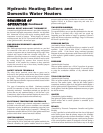
Hydronic Heating Boilers and
Domestic Water Heaters
54
DOMESTIC WATER
HEATERS Continued
This pump is sized based on installation of a single storage
tank and heater in close proximity. If the number of fittings and
straight pipe exceeds the quantities shown in this section, a
larger pump will be required.
The standard pump selection is based on the following pipe
and fittings from the unit to the storage tank:
Minimum Pump Performance
This is based on heating potable water with a hardness of 5 to
25 grains per gallon and/or total dissolved solids not exceeding
350 ppm. See Water Chemistry, page 52.
TABLE–W
Minimum
Pump
Heat Exchanger
This is a highly sophisticated heat exchanger, designed to carry
water in such a way that it generates a scouring action which
keeps all interior surfaces free from build-up of impurities. The
straight-line, two pass design of the tubes sends water into the
headers at a properly rated velocity. The configuration of the
headers, in turn, creates a high degree of turbulence which is
sufficient to keep all contaminants in suspension. This
“scouring action” provides greater cost savings for owners.
Tubes are always able to transfer heat at peak efficiency. Every
surface within this water containing section is of a non-ferrous
material, providing clear, clean, rust-free hot water. Straight
copper tubes-finned on the outside for maximum heat
transfer-coated cast iron one piece cored headers make up an
entirely rust-proof unit. On all models, header inspection plugs
can be removed for field inspection and cleaning of copper
tubes. The entire heat exchanger may be easily removed from
the unit.
Potable Hot Water Temperature Control
Settings
Domestic Water Temperatures
This unit has an adjustable temperature control to maintain the
desired water temperature set point. See Programming
Temperature Control, page 43, for instructions to program the
digital temperature control. The immersion thermostat or
electronic control is factory pre-set at approximately 125°F
(52°C) or less. Households with small children or invalids may
require 120°F (49°C) or lower temperature hot water to reduce
risk of scald injury.
Operate this high efficiency hot water heater at a temperature
setting high enough to prevent condensing of the products of
combustion on the unit’s heat exchanger or in the attached
venting system. A water temperature setting that is above the
dew point of the gas combustion products should prevent
condensate formation.
Storing the water at a higher temperature and thermostatically
mixing the water increases the available quantity of mixed hot
water, greatly reducing the possibility of condensate forming
on the heat exchanger or in the venting system and helps
prevent water born bacteria growth.
Some states may require a lower water temperature setting for
specific applications. Check local codes or your gas supplier
for domestic hot water temperature requirements. Remember,
no water heating system provides exact temperatures at all
times. Let system operate a few days at your programmed
settings to determine correct settings for your needs.
1. These units are equipped with an electronic operating
temperature control.
2. The electronic control set points are pre-programmed to a
low test setting when shipped from the factory.
3. Reprogram the temperature set points to the lowest settings
which will satisfy hot water demands, eliminate a possible
condensate problem and prevent a risk of scald injury.
Btu/hr Input GPM Ft.Hd.
399,999 - 750,000 55 10
990,000 - 2,070,000 90 15
TABLE-Y
Minimum Pump Performance
IMPORTANT: For every elbow and tee in excess
of those shown above, deduct 5 feet from
maximum allowable straight pipe in heater to
tank circulating loop.
6 - 90° elbows 2 - ball valves
2 - unions 1 - cold water tee
Not more than 45 feet of straight pipe.
ƽ WARNING: You must take adequate care to
prevent scald injury when storing water at
elevated temperatures for domestic use.
ƽ WARNING: To guard against scald injury,
you must use a properly-sized thermostatic
mixing valve to supply domestic hot water at
temperatures less than 125°F (52°C).


















